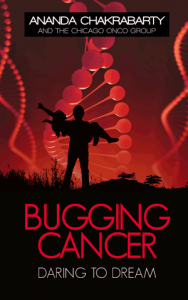Our very own Prashant brings for our readers a succinct and insightful review of a new book, ‘Bugging Cancer’, penned by the noted scientist Dr. Ananda Chakrabarty, who, as Prashant introduces adroitly, is “THE Chakrabarty from Diamond v. Chakrabarty.” So read on, folks!
Book Review: Bugging Cancer – A story of cancer, love, research and patents
Over the last few years the conversation about cancer and its treatment has been making a steady inroad into the mainstream discourse. After Siddhartha Mukherjee’s, Pulitzer prize winning, ‘Emperor of All Maladies: A Biography of Cancer’ we have ‘Bugging Cancer’, a fictional novel authored by the famous scientist Dr. Ananda Chakrabarty in collaboration with the Chicago-Onco group is an interesting effort to simplify for the common reader, complex issues of cancer research and patents.
For those of you who are unaware, Dr. Ananda Chakrabarty, is THE Chakrabarty from Diamond v. Chakrabarty, the landmark case where the U.S. Supreme Court, in a 5-4 decision, allowed for the patenting of a genetically modified bacteria developed by Dr. Chakrabarty. The USPTO had initially rejected the application on the grounds that living organisms could not be patented under American patent law. The U.S. Supreme Court shot down the contention on the grounds that everything made by man under the sun was patentable, the important feature being ‘made by man’.
The story line of ‘Bugging Cancer’ features two young scientists, Sam Roy, an Indian-Bengali immigrant to the U.S. & Brian Warten and tells the story of how together both scientists bankrolled by the fictional government of Bluefrostland develop an awesome new therapy which uses genetically modified bugs/ bacterial proteins, to cure cancer without the deadly toxic side-effects of chemotherapy. Apparently, the fundamental basis of this research already exists, with the authors themselves having worked on p28, a bacterial peptide which has demonstrated cancer killing ability and even cancer preventive activity with no associated toxicity. p28 has reportedly received limited FDA approval for trials on patients not responding to any other cancer treatment and the drug has actually worked to differing degrees on various patients, with at least one patient being completely cured. The fictional research in the book is of course much more advanced with the ultimate goal of modifying the human genome itself to protect against future cancers in people who have a genetic predisposition to be diagnosed with cancer.
The story of the research is weaved through the personal stories of the chief protagonists and explores the trials and triumph of research. For the patent lawyers who are reading this review you aren’t going to be happy with the book’s portrayal of either you or your wives! On the point of advocacy for stronger patent laws, most IP lawyers are likely to nod their heads in support of the author’s prescription for broadening the scope of coverage of global patent laws especially with regard to gene patents. However, the book, perhaps unwittingly, demonstrates how patents may actually not be necessary to inspire research and investment. The scientists in the book have personal motivations for the research that they are conducting (it love not the money!) and the main financial backing that they get at the riskiest stage of their research is from a very well funded publicly funded system albeit in exchange for their IP rights.
It would have perhaps been more interesting if the authors were able to provide an insight into how scientists negotiate their future IP rights with loan-sharks from the private sector investors like VCs or PEs and how patent law directly impacts such negotiations. That would have made a more compelling story for why stronger patent rights are required for gene technology. Further, given the Indian origins of the authors and the chief protagonist, it would have been interesting to see the authors to debate whether the same prescriptions for patent laws should stand in India, a country which is poor when compared to the U.S. Unfortunately that doesn’t happen in the book.
Nevertheless ‘Bugging Cancer’ is an engaging read for the simple reason that it provides a peek into the exciting research that is going to change the face of cancer treatment in the next decade. Humanity is finally in the last leg of its battle against the ‘Emperor of All Maladies’.
Interested readers can purchase the book on Amazon for Rs. 1,832 – it should also be available on other online stores.

